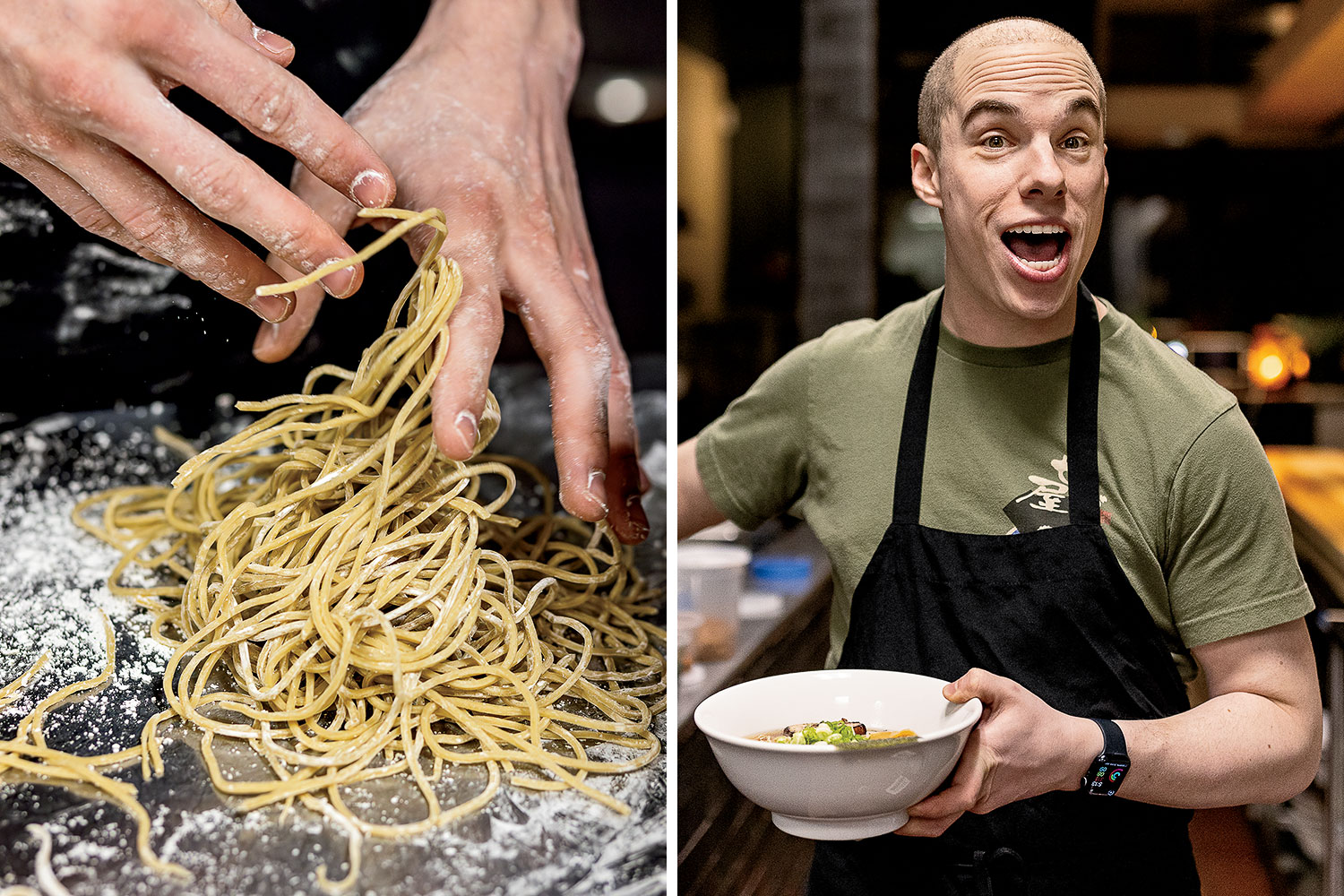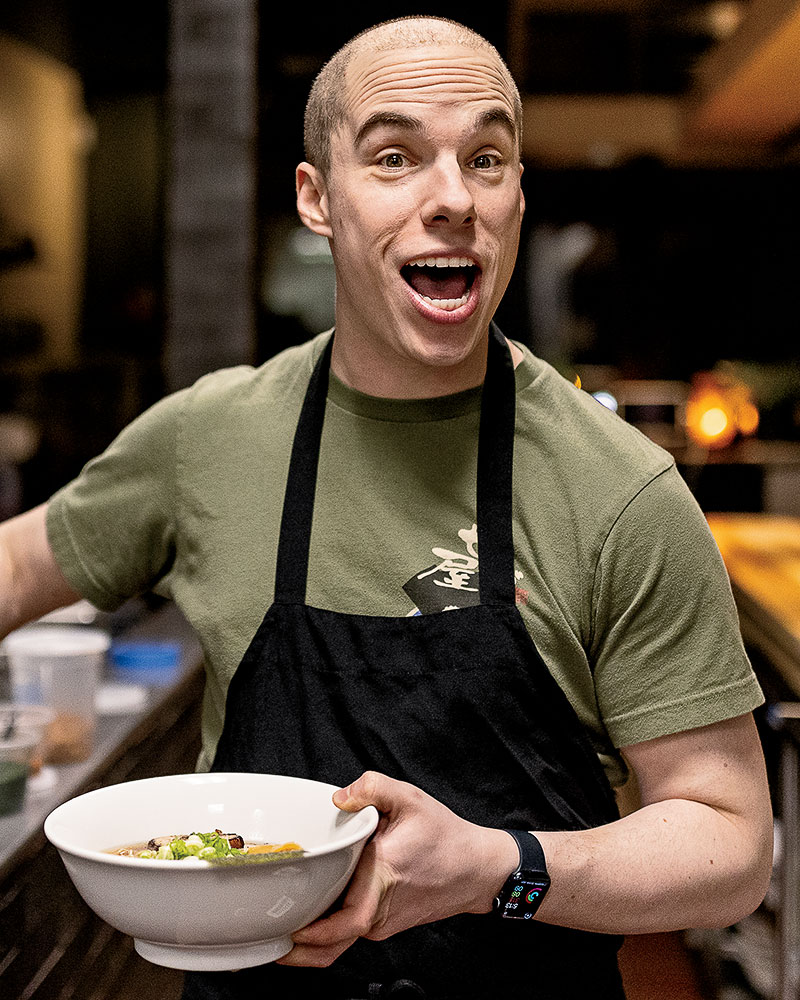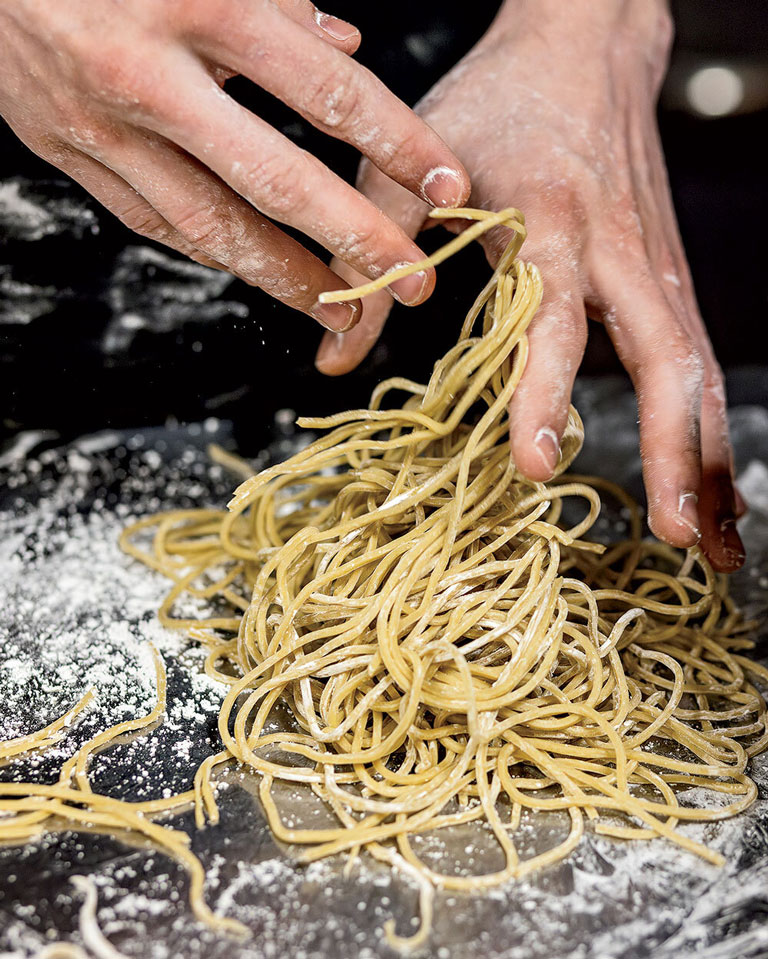For a guy who chugged a Ghost energy drink for breakfast, Mike Satinover has remarkably steady hands. They don’t jitter when he places a level, the kind you’d buy at Home Depot, on top of two logs of rolled-up dough sheets, resembling industrial spools of paper towels.
Rolling out ramen dough is exacting work. And Satinover won’t trust anyone else at his restaurant to do it — not until he can train someone properly, and that might take months. So with hands as still as a watchmaker’s despite three espresso shots’ worth of caffeine in his bloodstream, he adjusts the rolls of dough until the level’s bubble floats precisely between the center lines.
This ensures an even thickness when the machine he feeds the dough into pushes out what will become 300 servings of ramen noodles. Unfurled end to end, the sheets of dough he’ll make today would stretch 116 yards — longer than a football field.
Satinover, 35, sports peach-fuzz hair and a black Pippin’s Tavern hoodie that’s dusted with flour. As the noodle-making machine whirs and slowly coils, he takes out a pocket humidity gauge. The air inside his Logan Square restaurant, Akahoshi Ramen, measures 17 percent this winter morning, too dry for his ramen to remain as pliable as he’d like — 30 to 40 percent humidity is ideal. Already he’s had to repair some broken patches. Maybe he’ll buy a humidifier, yet one more unexpected expense.
Mostly, the man is exhausted. Energy drinks don’t get Satinover wired anymore, only lift him to a state of not-collapsing. But this is what he signed up for when he left his lucrative marketing job to toil from dusk till dawn in pursuit of serving a perfect bowl of ramen.
“I’m not getting good sleep. It’s pretty brutal,” says Satinover, whose restaurant has been packed since he opened it in late November. “I’m worried the mental and physical exhaustion will get to me.”
He continues feeding dough into the complicated and frightening Yamato Richmen noodle-making machine. It’s all buttons, rollers, and dials — 595 pounds of shine and chrome that could mangle appendages if you’re standing too close and not paying attention. At $40,000, it costs as much as a 2024 BMW 2 Series (shipping alone, from Japan, was $5,000), and for over a year it took up space in Satinover’s West Loop apartment, even before he signed the lease for the restaurant space.
His devotion to precision is astounding to behold, exasperating to capture in words: Three hundred servings of noodles (at 135 grams each) requires 30 kilograms of flour. But not just any flour. Over the years, Satinover has dialed in on the two types and the ratio he needs to hit the sweet spot of noodle firmness, a 13.2 percent protein level: 19,500 grams of King Arthur Sir Lancelot (14.2 percent protein) and 10,500 grams of King Arthur Sir Galahad (11.7 percent). Then, to give the noodles the toothsome chew and pale yellow hue he desires, he adds exactly 10,500 grams of water containing 330 grams of sodium bicarbonate, 150 grams of potassium carbonate, and three-eighths of a teaspoon of riboflavin.
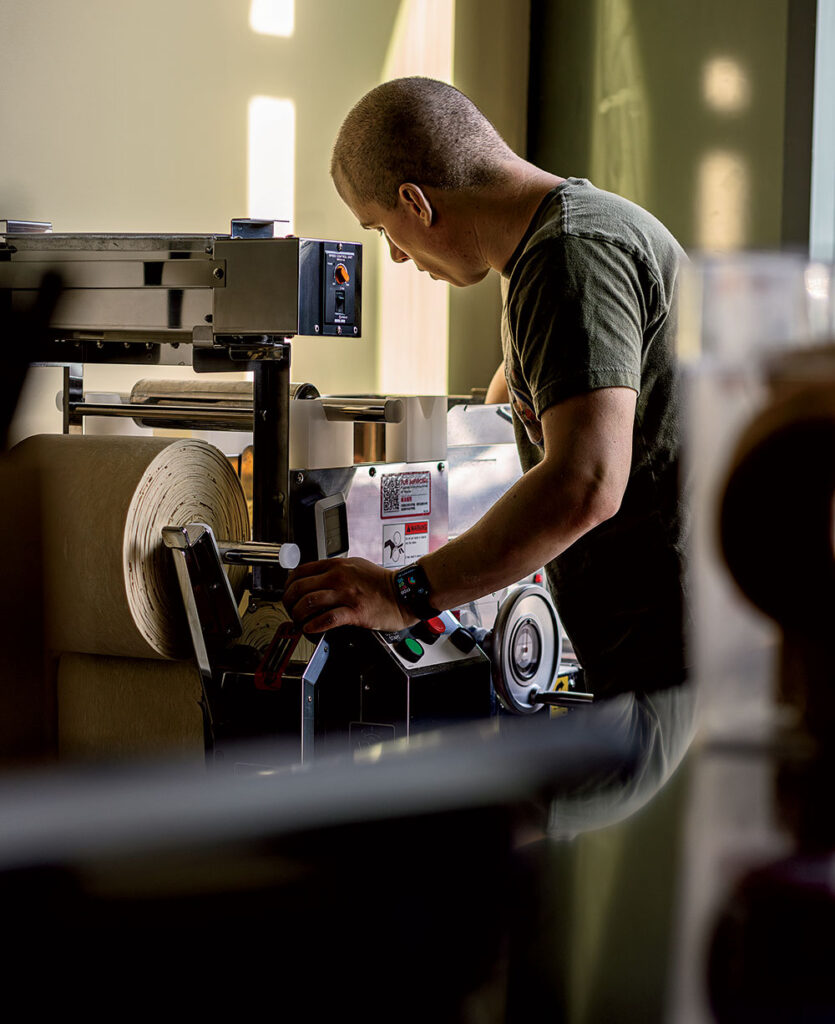
Even with a noodle-making machine as high-tech as Satinover’s, he can’t just set it and forget it. The noodles need to be pressed again and again. Ramen noodles are denser than, say, macaroni — if kept in broth overnight, good ramen noodles shouldn’t bloat. The dough enters the machine between two rollers, set at 1.5 millimeter thickness. Once it emerges, it’s folded by Satinover, then pressed again at specific intervals five more times before it’s cut into those familiar long strands. And that’s just the noodles for his miso ramen; for his soupless ramen, he uses a thicker noodle with an entirely different, but also painstakingly derived, formulation.
This noodle-making process eats up five hours of Satinover’s day, and it doesn’t include the 48 hours required for the noodles to sit in a sealed proofing box, commonly used for pizza dough, to age and develop flavor. All this should yield enough noodles to meet the demand for two nights of dinner service. But the way business is going at Akahoshi Ramen, the buzz surrounding it growing by the day, the reality is closer to a night and a half.
Striving for a perfect bowl of ramen — even if it can’t practically be achieved — requires more than feel, intuition, and thousands of hours of muscle memory. It demands exactitude measured in decimals, seconds, and milligrams, using levels, humidity gauges, and refractometers. It is cooking that veers into the domain of laboratory science.
Ask Satinover why this kind of precision is necessary — or really any question at all — and you’ll get an answer that is thought out, quantitative, ready to be bullet-pointed: “There are two reasons. From a business perspective, it’s consistency. My intuition about what’s right isn’t applicable to every component of every dish. I need a control, and numbers are easy to control. The other reason is to avoid having to think about it, to avoid the mental load of what’s correct and what’s not. The number is correct. Twenty grams of onions is correct, not 10 onions. What if you have a larger onion? It’s for a reduction in mental exhaustion.”
Satinover is a chef obsessed and possessed. But he doesn’t have the contemplative intensity of a Grant Achatz or Curtis Duffy — he is more in the mold of a chill gamer and sneakerhead, his cooking philosophy formed on Reddit, not at the Culinary Institute of America. His singular infatuation with ramen has served him well. For more than a decade, Satinover achieved esteemed status on Ramen Internet, which led him to roll out a series of pop-ups around the country and now to open what is Chicago’s most buzzed-about restaurant in years.
Anything is possible in America, even the redemption of a punch line. As recently as 20 years ago, outside of Little Tokyos and suburban strip malls catering to the Japanese, the idea of ramen as an American dining genre was a fanciful notion. Ramen was the staple of hungry and destitute college students. Ramen was chicken-flavored noodle soup from Maruchan, a dozen packets collecting dust in a food donation bin. Ramen in America was an avatar for cheapness and convenience, until it wasn’t. And now? People travel across multiple state lines just to sample a bowl of Japanese noodle broth because someone on Reddit said it was worth the trip. What a country.
Striving for a perfect bowl of ramen requires more than feel, intuition, and thousands of hours of muscle memory. It demands exactitude using levels, humidity gauges, and refractometers.
The online forum r/ramen is one of the friendlier corners of Reddit. The majority of posts by its 787,000-plus members feature photographs of homemade ramen attempted by amateur cooks. The photos are beautifully composed, the presentation of the ramen an art form in itself.
The more meticulous artisan will execute the “noodle fold,” which involves draping noodles over chopsticks, then carefully folding them once, all together, onto themselves, the individual strands aligned, resembling a three-dimensional barcode. Some bowls have ajitama — a soft-boiled egg marinated in soy sauce — that’s been bisected lengthwise, showcasing its oozy, lustrous yolk in all its sunflower-yellow glory. Amateur cooks are known to use an eyedropper to place precisely random beads of aroma oil — a fat such as butter or lard flavored with aromatics — on the soup’s surface in service of a gorgeous photo.
By and large, r/ramen feels like an encouraging place, with the genial vibe of a student art exhibition. Once the finished bowls are posted, there’ll be upvotes from fellow members, with comments like “Looks amazing” or “Great job!”
Spend any length of time on r/ramen and you’ll notice one user getting name-checked a lot: Ramen_Lord, often spoken of in language befitting actual deities (“Praise be to Ramen_Lord” and “All hail Ramen_Lord,” sayeth two recent posts). Since 2013, Ramen_Lord has earned his reputation by rigorously sharing every data point of his research on making ramen at home, hundreds of thousands of words now. If you’ve posted a photo of a homemade bowl on r/ramen, there’s a decent chance the recipe was developed by Ramen_Lord. At Satinover’s previous job, at the marketing research firm Kantar, a colleague learned Satinover was into ramen and suggested he check out the writings of the Reddit user Ramen_Lord.
What the co-worker didn’t know: Satinover is Ramen_Lord, a secret he kept from all but his family for nearly four years. Like many usernames, the self-glorifying moniker was intended as a joke. Satinover never imagined that one day he would, in fact, be viewed as a ramen lord.
It wasn’t until the food website Serious Eats interviewed the man behind Ramen_Lord in 2017 that Satinover outed himself. There was nary a a word about Satinover not being of Japanese ancestry, this gaijin who dared to call himself Ramen_Lord. By this point in the rise of ramen in America, the well-known names making it weren’t even Japanese: David Chang of the Momofuku Noodle Bar empire is a Korean American. Ivan Orkin is a New York native who ran beloved shops in Tokyo and New York and cowrote a bestselling English-language ramen cookbook.
Reddit users saw Satinover as someone who put in the work, who earned his stripes by being rigorous with his research. From the start, Satinover’s posts were treatises reminiscent of the recipe deep dives that propelled food writer J. Kenji López-Alt into culinary celebritydom. At a time when cooking content is condensed ever shorter, and more aspirational than useful, everything about Satinover’s instructions is slow and precise: Pork belly chashu should be cooked sous vide in a water bath at exactly 154 degrees Fahrenheit. For ajitama, the amount of soy sauce and mirin needed is 10 and 8 percent, respectively, of the combined weight of the peeled eggs and the water, which should be weighed separately.
There’s a culture of secrecy around ramen recipes in Japan, especially among shop owners in a fiercely competitive market. But Satinover wasn’t yet a restaurateur, just a hobbyist. Over the years, he would post a dozen recipes that he developed — from chicken paitan and tonkotsu gyokai tsukemen to a new wave Tokyo-style soy sauce — and these arrived on Reddit with the impact of a surprise Beyoncé album drop.
“I decided I’m just going to have no secrets, no matter what happens. I have to be an absolutist in that approach,” Satinover says. “The more I delved in, the more I realized they weren’t really my secrets to have. I’m not even Japanese. As an outsider, it felt very bizarre to think, Well, I have amassed this knowledge; let me just hoard it for myself. Why not share it? These things deserve to be known by everybody.”
Satinover’s most popular post was his most ambitious. In 2020, he and his twin brother, Scott Satinover, posted a free 137-page e-book called The Ramen_Lord Book of Ramen. There’s no fancy layout and only a handful of pictures — it’s just Satinover’s ramen brain downlinked to 47,351 words in a single-spaced Google doc. (A doctoral student in engineering, Scott helped write, edit, and explain the science.) Whatever poisonous reputation Reddit has sometimes earned, this was the very opposite: a community of like-minded folks celebrating something nice, flipping out in all-caps exaltations that its Lord had collected his wisdom into a bible.
A frequent question from Reddit users: When might they ever get to taste Satinover’s ramen in person. One-off pop-up dinners? Sure. But in that Serious Eats unmasking, Satinover was asked whether he’d consider opening his own restaurant. He replied: “I’m not sure I’m cut out for it. Loving a dish and loving making a dish are only part of the equation for owning a restaurant, and I have an immense respect for those who pursue that career, but it might not be my strong suit.”
Mike Satinover’s upbringing wasn’t dissimilar to that of other kids in 1990s Oak Park: He played a lot of video games, tried tennis and gymnastics, generally earned excellent grades. For a while, he was deep into spoken-word poetry, and his parents remember him obsessing over every word on his laptop to find the perfect imagery. “Mike has a goal in mind and then he pursues it with passion and vigor,” says his father, Ira Satinover, a retired oral surgeon. His mother, Luisa DiPietro, is a professor at the University of Illinois Chicago’s College of Dentistry.
Their son would spend long stretches of his days immersed in role-playing video games like Final Fantasy, the type of attention-span-testing contests where, Mike Satinover says, “you just have to grind to beat it — no shortcuts.” Later, in college, he would go through a phase of making macarons, the notoriously finicky Parisian confection. Over several years, he baked 38 batches, a few dozen cookies each time, documenting every attempt with detailed recipe notes.
In high school, Satinover had aspirations of becoming a chef. It was the alchemy and instant gratification, the possibility that, when it came to ingredients, one plus one plus one could equal five. When he was old enough to drive, he worked 20 hours a week as an unpaid stagiaire at an Italian restaurant in Forest Park. This was about the time Anthony Bourdain’s Kitchen Confidential became a pop culture sensation, and the restaurant industry’s seedy side was still being glorified as rock ’n’ roll. Satinover enjoyed the quieter parts — picking herbs and piping goat cheese into squash blossoms — but the head chef treated him like scum. “He called me all sorts of crazy names,” Satinover says. “He never taught me anything. It was all very unpleasant.” After a solid year of full-frontal shit eating, he couldn’t stomach the idea of entering culinary school, much less spending his life working in a restaurant.
His decision in high school to study Japanese (which interested him more than French or Spanish — that, and he was a fan of Dragon Ball Z) opened up new options. His junior year, he took a two-week trip to Nagano, Tokyo, and Kyoto, spending part of the time with a host family. An Italian Jewish gaming-obsessed geek who knew only upper-middle-class Oak Park, Satinover had his world rocked by Japan. Beyond the modernity and cleanliness, it was the cultural minutiae — like waking up to the smell of a rice cooker instead of an alarm clock — that most intrigued the impressionable 17-year-old. On a more abstract level, the collectivist culture of the Japanese, which stood in contrast to American individualism, was strange and strangely compelling to him.
When the time came for college applications, Satinover sought out schools with strong Japanese language departments. That’s how he ended up at the University of Wisconsin–Madison. He spent his junior year at Hokkaido University. It was there, in Sapporo, Japan, on a frigid November night in 2009, that one perfect bowl of miso ramen would slingshot Satinover’s life into a whole new trajectory.
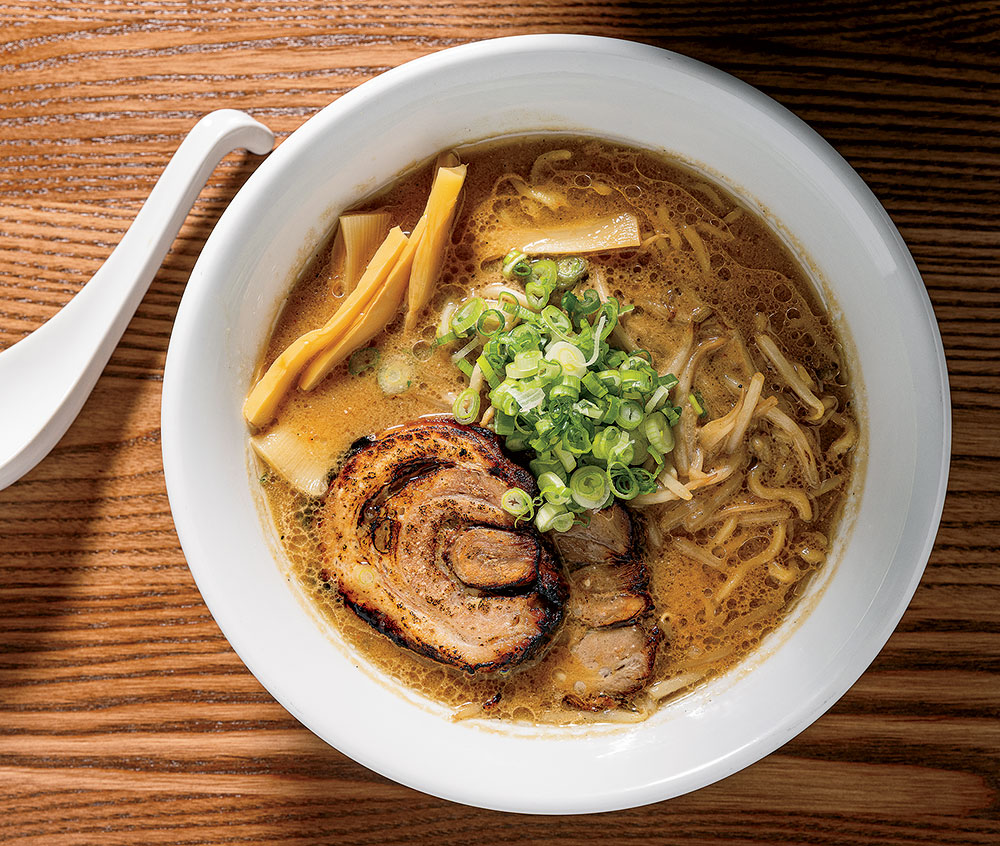
Sapporo has something in common with Chicago: It, too, is a northern city that endures bitter winters. The warming properties of ramen make the dish a popular elixir, and Sapporo boasts more than a thousand ramen shops in a city of two million people. The defining feature of Sapporo ramen (there are upward of 40 recognized ramen variants across Japan) is a broth cooked with miso, a fermented soybean paste. Unlike cleaner, lighter broths such as shoyu (soy sauce) or shio (sea salt), miso ramen is viscous and often creamy, its pungent, earthy savoriness particularly soul satisfying in cold-weather climates.
Sapporo-style miso is one of the few types of ramen requiring a wok. At searingly high temperatures, woks provide the requisite char (Chinese originators called it “wok hei”) that gives food an appealing, slightly burnt tinge. In Sapparo-style ramen, bean sprouts (or cabbage) with a thick dollop of miso paste first get this charring, the flames from the gas burners licking high and caramelizing the sugars. Pork broth is then ladled into this stir-fry, and within seconds everything comes to a vigorous boil.
Satinover was hooked after his first bowl at a legendary miso ramen shop in Sapporo, Japan. “My brain couldn’t comprehend what this really was in terms of composition. I didn’t understand that you could make food taste like this.”
What happens next necessitates nimble hands and tight choreography. As soon as the curly yellow noodles come out of the cooking water, they are shaken dry to remove excess moisture (overcook them by even 10 seconds and they’ll lose that springy chew). When they land in the serving bowl, the wok broth with bean sprouts is poured over top. Toppings — pork belly chashu, strips of bamboo shoots called menma, scallions, sometimes corn and butter — are nestled into the noodles. Then the finished bowl is quickly dispatched to the diner. Assuming every component is properly prepped, a bowl of miso ramen should take less than four minutes from cook to serve.
Satinover knew none of this when a fellow student recommended he visit Sumire, a legendary miso ramen shop in Sapporo. The only ramen he’d had theretofore was of the instant packet variety, plus a few bowls from the food court at Mitsuwa Marketplace in Arlington Heights. He wasn’t yet a superfan, but the dish sounded more exciting than the broiled fish and steamed rice served at the dorm canteen.
When the ramen bowl arrived at his counter seat, it was nothing pretty: yellow noodles submerged in murky beige with a tangle of light green scallions. On the surface of the soup was what looked like a quarter-inch layer of liquefied pork lard. This insulated a scalding hot broth, McDonald’s-coffee-lawsuit hot, a temperature many degrees higher than what American restaurants would serve.
Here’s the part of the biopic where Paul McCartney sees the guitar in the music store window or Dorothy enters the Technicolor world of Oz: The first sip burned his mouth.
Ask Satinover to describe how the ramen tasted, and he’ll respond by telling you how it made him feel: incredulous. “My brain couldn’t comprehend what this really was in terms of composition. I didn’t understand that you could make food taste like this,” he says. “There was something immensely pleasurable about it in a core, visceral way. Nothing was wrong. Everything was correct.”
If ever a bowl of noodles could kick your ass, Sumire’s miso ramen did it to Satinover with steel-tipped boots. For the first time since arriving in Japan, he was tasting food in the outer bounds: intense savoriness, extreme richness, wobbly fat from the chashu, bean sprouts charred dark. As he sat alone at this second-floor walkup in Sapporo, his life changed, even if he didn’t know it at the time. But the problem with losing his ramen-in-Japan virginity to something so maximally delicious was that it set Satinover up for a high nearly impossible to replicate, like having Gisele Bündchen as your first girlfriend.
Satinover’s ramen bell couldn’t be unrung. Every free moment in the coming months was spent at a ramen shop, slurping, chasing that dragon. So obsessed was he that he proposed doing an independent study at school, documenting and reviewing ramen shops in Sapporo. (Basically, a food blog.) There would be lengthy write-ups of restaurants, photos, interviews with chefs, Google Maps listings. In his introductory post to the Sapporo Ramen Guide, still online today, Satinover wrote (grammar cleaned up slightly):
So, using my decent-at-best Japanese, I will be compiling some of the best, and some of the worst, shops there are, written for your pleasure and use. I will do the research, I will conduct the interviews, I will ask the questions, then show you the results, so you don’t have to.
Two months and 21 posts later, his teacher scored his project 98 out of 100.
When Satinover returned to the University of Wisconsin to complete his degree (in addition to Japanese, he also majored in international business and marketing), he began feeling an intense yearning. The one place in town serving ramen might have been fine for Madison, but it was inadequate for someone who had visited nearly a hundred ramen restaurants during his year abroad. He describes what he felt as “deep reverse culture shock”: “I was like an addict. I went from eating this thing all the time to not having it at all. I missed the memory of it. I had a lifestyle, and that lifestyle was immediately stripped from me in an intense, difficult way.”
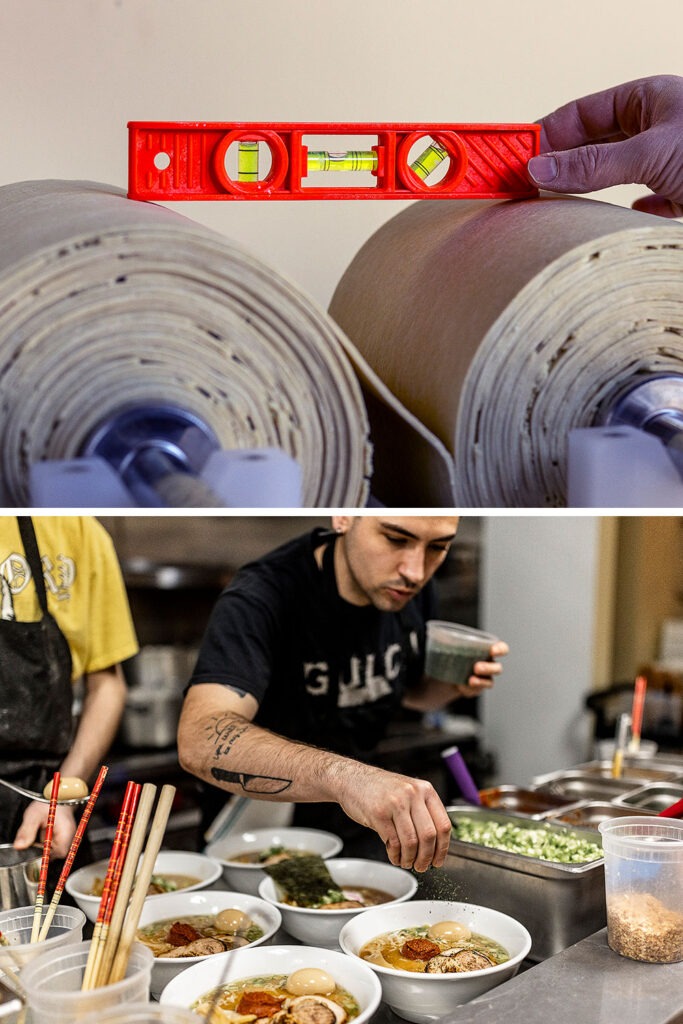
Let’s pause to look back at Chicago’s fledgling ramen scene, circa the early 2010s. It’s not like ramen wasn’t around then, but the offerings here were of the mom-and-pop variety, with no online footprint, no publicists — the types of places Eater wouldn’t hyperventilate over. There was one spot where local ramen geeks got their fix: Santouka, the noodle chain with an outpost in Mitsuwa’s food court. But Arlington Heights was so far away that city dwellers had to pay the Illinois Tollway each time they wanted a bowl.
If there was one chef who helped ramen achieve “city cool” in Chicago, it was Bill Kim, who spent time under Charlie Trotter. Kim’s restaurant Urbanbelly, which opened in 2008, had a few things that lent it street cred: It was next to a laundromat in a sad Avondale strip mall, its interior design oozed hipness, and its seating was communal benches, which, apart from Avec, was still a novel concept here at the time.
Kim, a Korean American, served an array of pan-Asian dishes, including lamb and brandy dumplings and a killer pineapple and pork belly fried rice. Urbanbelly also offered ramen, and though it didn’t adhere to traditional Japanese interpretations, it was nonetheless delicious: The restaurant’s flagship bowl featured pork belly and shiitake mushrooms in a broth tinged with pho spices, lime juice, and fish sauce. I suppose you could call that pho, but the noodles were ramen-style.
After Urbanbelly, Chicago’s culinary scene began treating ramen as a fine-dining novelty. (Wagamama was already doing this in London, and David Chang was making waves at his Momofuku in New York.) Around this time, chef Takashi Yagihashi started serving shoyu and miso ramen in the food court at the Macy’s store in the Loop and during Sunday brunch at his namesake white-tablecloth Bucktown restaurant. Those led to Slurping Turtle, which he opened in River North in 2011. After that, Oiistar made a splash in Wicker Park, buoyed by its Yamato noodle-making machine.
Chicago’s ramen renaissance truly arrived in the mid-2010s: High Five Ramen from the Au Cheval team, Furious Spoon, Wasabi, Ramen Shinchan in Palatine. Nick Kokonas, the financier behind Alinea and later the Tock reservation system, said he considered opening a place called Fuck Yeah Ramen.
But for Mike Satinover, posted in the ramen hinterlands of central Wisconsin in 2011, his Sapporo noodle experience became a phantom limb, an itch that couldn’t be scratched.
The only solution was to make ramen himself. Early attempts were predictably awful. The process of making a bowl from scratch is so labor intensive that most amateurs would have given up after one go. But just as it had with macarons, Satinover’s predilection to try, tinker, and try again kicked into gear. His motivation this time was a deep yearning, a physical craving for that one perfect bowl of ramen. So he kept going.
By night he was the mythical Ramen_Lord, chronicling every step of his ramen journey for an online fan base. By day, Mike Satinover made use of his business degree, working as a marketing research analyst. The decade he spent in that job gave him an understanding of consumers and of the product features that appealed to different types of them. (For example, how willing would someone living in the West Loop be to pay $19 for a bowl of ramen?)
He reached, then blew past, his 10,000 hours for mastery a number of ways. Early on, he’d make a bowl of ramen from scratch once a month, and as he became more proficient, he upped that to once a week, then two, sometimes three bowls a week. Over the years, he amassed two dozen Japanese-language ramen cookbooks. He’d discover these during weeklong pilgrimages to Japan, where he’d consume between three and five bowls daily — “a very normal amount,” Satinover contends — fastidiously documenting his research on Reddit and Instagram.
What improved Satinover’s ramen making most swiftly was hosting pop-up dinners around the country, the first in 2017 at New York’s Ramen Lab, an incubator for ramen chefs by the noodle manufacturer Sun Noodle. He’d get in his reps making as many as a hundred bowls a night. Driven by Satinover’s growing profile on social media, coupled with a 2017 profile in the Chicago Tribune, his pop-ups became a hot item. He’d release the tickets on Tock at noon, and within 30 seconds, all 90 seats would sell out. Satinover branded his pop-ups Akahoshi Ramen — the name means “red star,” a symbol that, fittingly and remarkably, appears on the flags of both Chicago and Hokkaido prefecture, of which Sapporo is the capital.
Satinover harbored dreams of quitting his lucrative day job to make ramen. But how? His celebrity on Reddit opened access to a network of professional chefs. “For something in the English language about ramen that showed proper technique, how to source ingredients, how to make proper tare, there was no one else before Mike posted on Reddit,” says Scott LaChapelle, who runs the acclaimed Rhode Island ramen shop Pickerel. “There was no information online, and Mike propelled that forward.”
There’s little consensus on who’s the best ramen chef in America, but Keizo Shimamoto is on the shortlist. A Japanese American who blogged about ramen, he relocated to Tokyo for four years to learn how to make it. That devotion earned him a starring role in the 2013 documentary short Ramen Dreams. When he returned to the United States, he created the ramen burger (a hamburger with a bun made of crispy noodles), which became a viral sensation, and opened his acclaimed shop Ramen Shack in New York City and a second location in Orange County, California.
Satinover dined at Shimamoto’s New York restaurant and introduced himself. Soon the two became friends. Satinover invited Shimamoto to his Chicago apartment, where he served him his interpretation of miso ramen. “It’s top notch. I was really impressed,” Shimamoto says. “I fell in love with miso ramen in Sapporo, and having Mike’s in Chicago and getting that Hokkaido Sapporo feeling, that’s what makes me emotional.”
Shimamoto adds: “He tells everyone I’m the best ramen chef in America. He’s definitely taking that crown pretty soon.”
It’s one thing to control every variable and cook one perfect bowl of ramen in your apartment. It’s something else entirely to scale this up to serving 200 bowls a night to a paying public with sky-high expectations. There’s the practical realities of opening a brick-and-mortar restaurant. (Running joke: How do you become a millionaire as a restaurateur? Be a billionaire, open a restaurant, and run it until you become a millionaire.) Even if the margins are decent, invariably there will be supply chain issues and fluctuating food costs. You’ll need to train staff members to replicate your ramen faithfully, only to have many of them leave the job after a few months. Then there’s dealing with the weekly torment of municipal bureaucracy.
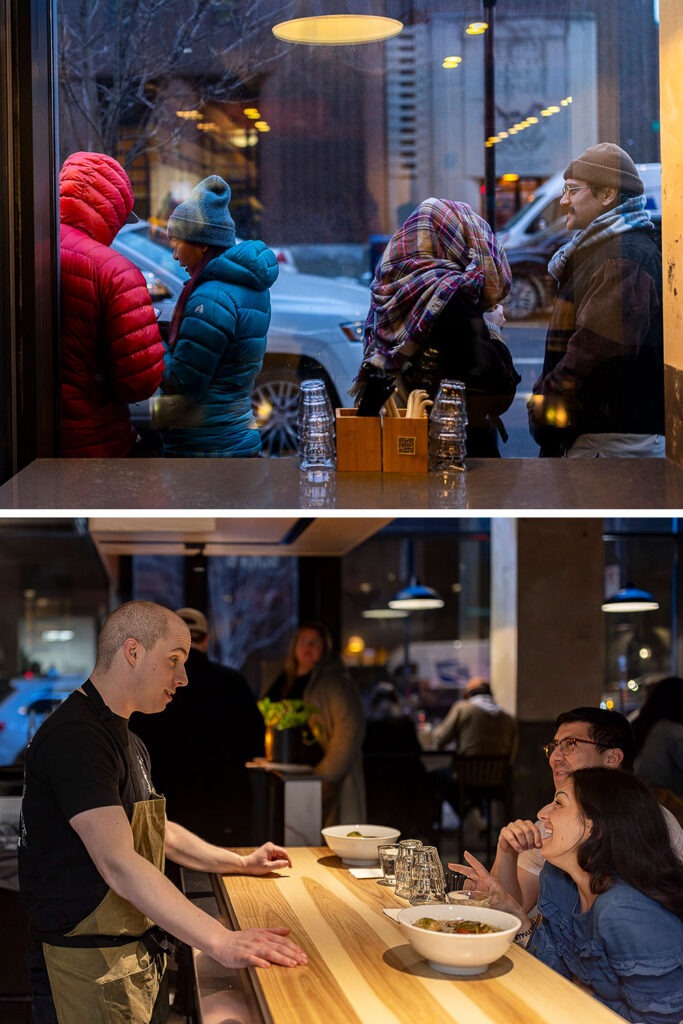
Every pain point makes attaining that one perfect bowl even more difficult. Shimamoto himself urged Satinover not to open a restaurant. In 2022, Shimamoto closed his remaining Ramen Shack in California. In addition to the staffing and supply issues that led to the decision, Shimamoto says, physical and mental health issues had taken a toll on him: “Whether you’re making a million bucks or not, you struggle and question daily what the point is of everything.”
Running a restaurant isn’t the domain of a talented hobbyist. Satinover knew scrutiny and bad reviews would come. And even though he could speak Japanese, he recognized that the optics of a white man making Japanese food and being heaped with acclaim for it weren’t great, even if the criticism came largely from white people on social media. “I doubt very much that the best ramen is in some white guy’s house,” one Facebook commentator wrote in response to the 2017 Tribune story. Satinover’s personal Facebook account was flooded with messages from people calling him a cultural appropriator — but not one of those people, as far as he could tell, was Japanese. (Several Japanese friends tell me that when gaijin come to Japan and attempt their culture’s cooking, the locals view it not as appropriation but as appreciation of their cuisine.)
It’s routine that chefs — white chefs in particular — who devote their culinary lives to a cuisine not of their ethnic origin hear about it from the online cultural appropriation police. The really successful ones, like Andy Ricker, formerly of Portland’s Pok Pok empire, and Rick Bayless, Chicago’s Mexican food devotee, mitigate criticism by being fastidious in their research and respect for tradition. They speak the language, they spend time living in the country, they dive into the cuisine headfirst.
Of those who criticize him, Satinover says this: “It doesn’t matter that I studied Japanese throughout high school and college, that I majored in Japanese. It doesn’t matter. I’m not Japanese, I’ll never be Japanese.”
It would be one thing if this were a passing fancy for Satinover. But it’s a deeply embedded desire of his — one he can’t deny himself. He decided against outside investors because he didn’t want to compromise on his vision. So he poured his life’s savings into Akahoshi Ramen. His goal is simple enough to be written on a napkin: He just wants to make ramen for a living. And he is fine, at least for now, earning a third of his marketing job salary to do it.
“Just doing the math, there’s no return on investment here,” Satinover says. “It’s to have my dream ramen shop. I need my own ramen shop. I don’t care if it makes money or not. I would just hate myself if I didn’t have my ramen shop.”
Over the last few years, this pursuit has provided plenty for Satinover to talk about with his therapist. Recently, their sessions have focused on pushing back against the high expectations of others and, in a way, the voice in his own head. Satinover feels a particular turmoil in accepting praise: He needs a certain amount to satisfy the ego, but he also feels dishonorable when the word “best” gets foisted on him. It sets him up for failure.
“ ‘Best’ is what I’m working towards, and when I get it, I don’t like it,” he says. “How do I give myself more compassion to enjoy the fruits of my labor, instead of beating myself up?”
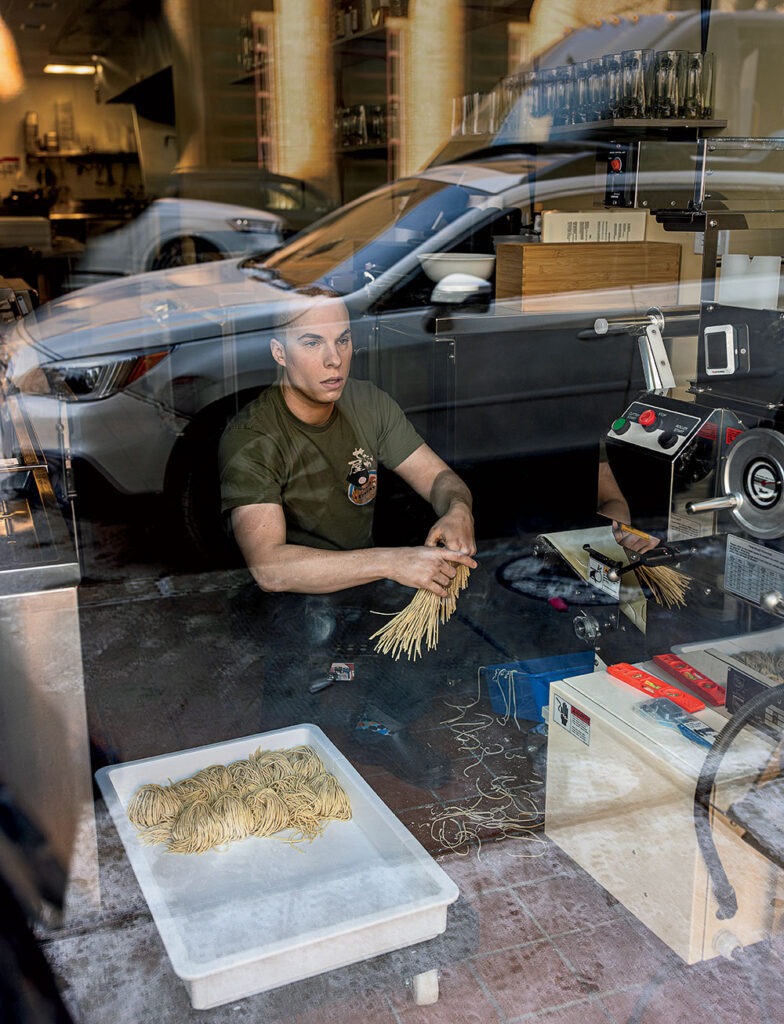
Fourteen years nearly to the day he tasted that life-changing bowl in Sapporo, 70 days after quitting his marketing job, Mike Satinover peeled back the butcher paper taped over the windows and doors, wiped the glass clean, and opened Akahoshi Ramen to the public. It was the night after Thanksgiving.
He had installed a seven-seat counter, where you could watch him assemble bowls, like you might at a shop in Sapporo. What felt more like an American restaurant were the additional 50 tabled seats, where you could dine more leisurely and, ideally, order a few yuzu highballs to drive up the check average. He had assembled a team of four cooks and five front-of-house staffers. One of those cooks, a longtime fan of Ramen_Lord, DM’d Satinover about working for him the day Satinover announced Akahoshi on social media.
Satinover had learned that if you try to please everyone with options, you risk pleasing no one. So he kept his menu intentionally sparse: four types of ramens, two rice dishes, and extra toppings. That’s it. There is no tonkotsu, the crowd-pleasing, bombastic, pork-fat-laden ramen that’s seemingly obligatory on every ramen menu in America.
His signature bowl is, of course, the Sapporo-style miso ramen, made with a blend of three miso pastes imported from Japan. Also on the menu is a lighter variant, the soy-sauce-based shoyu, as well as tantanmen, a Japanese take on the Sichuan street food dan dan noodles. This bowl does not have broth; instead, it’s mixed with a cool sesame sauce and topped with numbingly spicy crumbles of ground pork. Satinover’s final ramen is also soupless: aburasoba, a garlicky, soy saucy variant with fried scallions and a generous heap of chopped pork belly.
“We only have four ramen, so each one has to be pretty awesome,” he told me as he prepared for the opening that night. “If it’s not awesome, we’ll have a problem.”
The best word to describe the scene in the restaurant hours before the first-ever customers arrived: “boring.” Satinover was washing dishes, sipping his dinner of Monster Energy Ultra Sunrise. The pork belly chashu sat sliced in a hotel pan in three-ounce portions. The broth had been heated to exactly 203 degrees Fahrenheit, a temperature that won’t agitate and cloud the soup. A line cook was snipping toasted seaweed with a pair of scissors. Satinover offered the cooks their choice of prep music, and they chose an album called Impenetrable Cerebral Fortress by the hardcore metal band Gulch. Everything was prepped and precise.
At 5 p.m., the music was switched to something less cranium crushing and more low-fi chill, and soon Satinover called out the restaurant’s first orders: “Two shoyus, two misos, please!” The first tantanmen came out of the kitchen at 5:30; Satinover was delighted that the diner asked for extra chile oil.
“I’ve prioritized this restaurant over everything else in my life. I have no other hobbies, nothing else is driving me. It’s more important than friends, my own mental and physical well-being. And I’m kind of OK with that.”
From the open kitchen, Satinover hobnobbed with well-wishers, many of whom were regular attendees of his pop-ups, and accepted liquid gifts of congratulations. Unlike the ramen culture in Japan, where diners eat as quickly as possible, then leave, Akahoshi has a relaxed come-stay-for-a-while air about it.
Judging from messages reposted on the restaurant’s Instagram feed, customers — including local food writers — enjoyed what they tasted. Nick Kindelsperger, who has since left his post as a Tribune food critic, was among the first diners that opening night, and he posted on Instagram: “This is the best ramen I’ve had in Chicago.”
But there were issues that first week. One night, the ajitama sat too long in the warm soy sauce marinade, so instead of the oozy lava flow, the yolks were fully hard-boiled. Some of the soup was overly salty because the broth wasn’t properly diluted. Another night, the bok choy on the tantanmen was ice cold. The toilet in one of the restrooms overflowed.
Five days in, Eater Chicago published a story about the restaurant’s growing popularity under the headline “Akahoshi Ramen, Now Open in Logan Square, Is Chicago’s Toughest Reservation.” Satinover wasn’t thrilled about that, because it’s not entirely true, as he allocates 50 seats to walk-ins nightly. Between a reputation for hard-to-score reservations and the early adulation from reviewers, Satinover had a creeping sense that the lofty expectations were getting pushed further beyond reach. He’s already heard from a number of customers that $19 a bowl is too expensive. One Google reviewer questioned whether those claiming Akahoshi has the “best ramen in Chicago” were paid off by Satinover.
“The major criticism of this restaurant is that it’s overhyped,” Satinover says. “I knew we would have this problem, I just didn’t realize how much.”
As a former food writer at the Tribune and an avowed ramen geek, I’ve tasted a good sampling of bowls around town. How does Satinover’s stack up? I find his interpretations fantastic — the miso and tantanmen in particular. I’ve had countless other bowls that leave me feeling like I ingested a fat-and-salt bomb. Akahoshi’s are rich but not heavy. The flavor is subtly robust, and the noodles have an appealing bounce. Everything about the bowls tastes clean and unadulterated.
I think part of why Satinover’s ramen seems so exceptional to me is that I have been given privileged information. He painstakingly walked me through the choices he made in composing each bowl. He explained to me how he gives the noodles the requisite chew. I saw him scoop out the three-miso blend used for the tare, the primary seasoning agent that contributes the earthy, sweet-savory undertow in his miso ramen. I watched him use a refractometer to make sure his broth had the proper viscosity. Would a casual diner, without all that, appreciate Satinover’s ramen the same way?
Apparently so. As I watched Satinover prepare the dough that morning in early December — Akahoshi Ramen’s 11th day in business — he spat out his restaurant’s scores for me like a die-hard Bulls fan reciting Michael Jordan stats: On Google, Akahoshi had exactly 39 reviews, with an average of 4.7 stars; on OpenTable, it had 70 reviews, all but one a five-star rating. The previous night, 147 customers walked through the door, ordering 180 bowls of ramen. (Weeks later, Satinover would serve 197 bowls in four hours.)
A normal day at the restaurant for him is 14 hours. And a little more than a week into his new life, he was very tired. Asked on Reddit what he misses from his old desk job, Satinover answered that it was not having body aches all day long. “I’ve prioritized this restaurant over everything else in my life,” he told me. “I have no other hobbies, nothing else is driving me. It’s more important than friends, my own mental and physical well-being. And I’m kind of OK with that.”
This is his new reality, from now until the day his restaurant shutters: coming to terms with the fact that making one perfect bowl of ramen 180 times a night is impossible and futile. Where does one cede control? What compromises will need to be made? And when others proclaim you the most exciting ramen chef in America, is that just putting a target on your back?
Satinover thinks about all this often — it’ll be fodder for his next conversation with his therapist. But that morning there were more pressing issues. He needed to finish making those noodles. And he had just gotten word that his dishwasher had a DJ gig that night and wouldn’t make dinner service. Satinover was going to have to wash 180-plus bowls himself.



